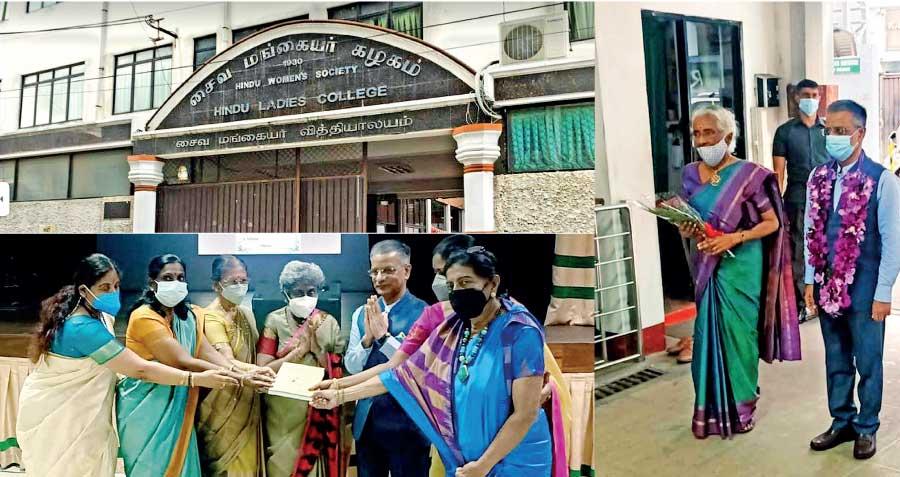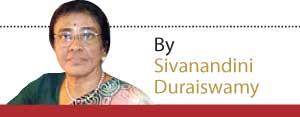Reply To:
Name - Reply Comment
Saiva Mangaiyar Kalagam celebrates 90 years of selfless service to the community

The 90th anniversary of the Saiva Mangaiyar Kalgam was marked at a simple event at the college auditorium on Friday, December 10. The picture shows Chief Guest High Commissioner of India Gopal Baglay after ceremonially handing over the copy of the book Achievements to the Saiva Mangaiyar Kalagam members.
The year was 1930! The date was 10th December when Ceylon was under Colonial rule and the Hindus were at the crossroads losing their innate Hindu Tamil identity.
the crossroads losing their innate Hindu Tamil identity.
That was the time when a band of young Hindu women embarked on their journey to form the Saiva Mangaiyar Kalagam, to foster their language, religion and culture. The first step they took was to form themselves into a Women’s Society under the benign guidance of Swami Vipulanandaji of the Ramakrishna Mission and Mudaliyar Rasanayagam.
Last week, on December 10, four scores and ten years later, we observed our 90th Anniversary presenting our story in the book form - “Achievements – The Kalagam and Its Institutions,” of the past ninety years.
It needs to be written so that future generations would know its beginnings, its objectives, how these objectives were fulfilled and how we see them now in their present form. We could not have timed it better, given all the change that is happening around us.
The Kalagam was founded and in keeping with the three objectives, the Founder Secretary says in the Silver Jubilee Magazine, “…within a year of our inception, we made the momentous decision to start a Secondary School for girls,” a new structured educational institute, remembering Mahatma Gandhi’s words – “Teach a girl and you teach the family.”
The foresight of these pioneer women could be summed up in two valuable decisions they made – namely That Language and Religion were vital in the educational programme of children and The importance of Aesthetic Studies in the curriculum, especially for girls
These decisions and the founding of the Vidyalayam marked the momentous departure from the prevailing traditions - education of girls in the mother tongue in an atmosphere of the age-old Hindu traditions with music and dance as subjects in the curriculum.
The Saiva Mangaiyar Vidyalayam was born with seven students in the Theosophical Society, Colombo and by 1933 moved into its own premises in 34th Lane, Colombo 6. Recognizing the talents and administrative skills of a young graduate from Women’s Christian College in Madras, Nahammal Kasipillai was appointed as the Principal of the school.
The Kalagam in its formative years of the nineteen thirties was a very active society. The women joined hands to develop themselves and those around them, at a time when alien culture and religion were the norms.
Mahatma Gandhi, Kamala Chatopadhyaya, Sarojini Naidu who had visited Ceylon during those years influenced them a great deal. They started spinning and weaving classes, learning the Thirukural, organizing religious lectures by the erudite Swamijis of the Ramakrishna Mission. They joined the Tamil Women’s Union to felicitate the first Women Councillors Mrs Naysum Saravanamuttu and Mrs Adeline Molamure. Above all they had the wonderful opportunity in the nineteen thirties, to receive great personalities like Pandit Jawaharlal Nehru, Kamala Nehru, the Maharanis of Baroda and Mysore, Mrs Vijayalakshmi Pandit and others. Later they were also able to receive spiritual personalities like Suddhanadha Bharati, Swami Shivananda, Swami Ramadas and Annai Krishnabai,
Miss Kasipillai under the guidance of the Management built up the school through the Grant-in-aid Scheme of the Education Department into the Kannangara Free Education Scheme when the department wanted the subjects of music and dance removed from the curriculum.
"In the late nineteen forties and early fifties when Mme. Maria Montessori came to Sri Lanka, from the Theosophical Society in Adayar, the Kalagam was able to invite her in 1951 to inaugurate the Montessori school"
And in 1945, in keeping with its third goal – to foster Hindu culture, music and dance – subjects that had to be removed from the school curriculum, the members founded the School of Carnatic Music and Bharatha Natyam in 1945 – the Kalai Kshetram – the Temple of Arts – this was the only school of its kind in the country offering a variety of instrumental music, vocal music, dance and theory.
This School of Music and Dance blossomed beautifully. During the mid-nineteen fifties, the school’s orchestra and its dance troupes were invited to perform in Chennai at the music festivals, literally carrying coals to Newcastle – seats of Carnatic Music and Bharata Natyam and to perform at Vignan Bhavan in Delhi invited by Mrs Indira Gandhi.
In the late nineteen forties and early fifties when Mme. Maria Montessori came to Sri Lanka, from the Theosophical Society in Adayar, the Kalagam was able to invite her in 1951 to inaugurate the Montessori school.
Today this has grown into a lovely home for children – the Casa Bambino as she would have wanted it to be.
It was in May-June 1958 that the Kalagam faced its first challenge, brought about by the communal riots that hit the Tamils badly.
Most of the Tamils in Colombo moved back to their homes in the North and East of the country. The number of students on roll declined. Several more communal riots hit the Tamils, and at the receiving end of these was the Kalagam.
However, the proverbial phrase, ‘Time and Tide wait for no man,’ proves the fact that while the number on roll comes down, creating difficulties for the school, with time it gradually goes back to normal and we pick up the threads from there!
In 1960, the Sivananda Nilayam, a prayer and meditation hall was built for the Kalagam by Mrs Tambiah. This was used as the Assembly Hall for morning prayers by the Vidyalayam.
1960 was also the year the denominational schools of the country were taken over and the Kalagam decided not to hand over the Vidyalayam to the Government but keep it as a non-fee-levying Private Hindu School. All the Hindu associations handed over the Hindu schools to the Government.
The following years were indeed very difficult especially in being ‘non-fee-levying,’ and finding monthly sums of money to pay for all the expenses.
“Find,” the Kalagam did, and the caravan moved on, chugging slowly, occasionally coughing, yet surely moving on! It was only in 1977 that a Norwegian NGO came to our rescue.
Soon after, the government decided to assist these private denominational schools and the Vidyalayam became an Assisted Private School in 1980 by paying the salaries of the permanent cadre of teachers.
In 1972, the Principal felt that since the school had become an “A Grade Institution”, a school hostel was necessary and the Mangaiyar Illam was restarted.
During the war years, this became an important part of the Vidyalayam and many students from the peripheral areas of the island joined the school staying in the hostel.
A few years later the Balambigai Namasivayam Illam - the Home for Elders was also formed in the home of our Founder Mrs Namasivayam who was widowed early in life and remained single. She had a bad fall which incapacitated her greatly during her tenure as President. The Kalagam looked after her during her last years and she gifted her home to us wanting us to make it into a Home for Elders which is being managed by us.
In the mid-nineteen eighties, the Kalagam had a reprieve – a growth spurt when a few Embassies funded our Vidyalayam building project including three Memorials to our founders consisting of classrooms, laboratories and office rooms. We grew physically and by the early 1990s, the school became 1AB on par with the National Schools of the country.
Together with this growth, we grew academically as the Management realized that there was a need to raise the education of the children by combining the English language as a medium of instruction.
Bearing in mind that education should be first in the mother tongue Tamil, we started English medium classes gradually from Grade 3 upwards – through bilingual classes to all the streams in the Advanced Level classes. And with time, the Vidyalayam evolved into a grand edifice formed on the firm foundations laid by our forebears.
At present we have over 2,400 and an academic staff of 120. The national curriculum is followed with extra classes to give the students the extra push to expand and face the challenges in the present competitive world. These are reflected in the results our students achieve in the different examinations – G 5, Ordinary Level and Advanced Level.
Last year as we were stepping into our ninetieth year, the pandemic situation disrupted the smooth functioning of all the Kalagam’s institutions it had founded – namely the Vidyalayam, the Montessori, the hostel, the School of Music and Dance, the prayer and meditation Centre and the Elders’ Home.
However, the Vidyalayam and the Elders’ Home which now consists of elders and a Working Women’s wing, were quietly and efficiently functioning through the lockdowns.
The pandemic changed the modus operandi of the education set up completely in the island, tying it up with very special health rules of sanitizing the hands, wearing masks, keeping distance from others, curfews, lockdowns and vaccinations. However, during those early days, with my experience in the Chinmaya Mission online Zoom classes, the Principal Mrs Rajavijayan’s experience in the educational field and greatly assisted by the teachers, we were able to steer the Vidyalayam virtually into the new normal digital era from the Montessori to the Advanced level classes. To break the monotony of the teaching and learning programmes, the activities of the various societies of the Vidyalayam have also been presented on the online virtual platform where the respective students play a key role in the presentations.
I could proudly say that we the Management, the Principal and teachers received praise from the parents and general public for our ability to switch over from the old to the New Normal.
As the Kalagam reaches another milestone in its long journey of 90 years, it has become a beautiful endeavour for me to reminisce and recapitulate events from the past.
The writer, Sivanandini Duraiswamy, is the President of the Saiva Mangaiyar Kalagam.